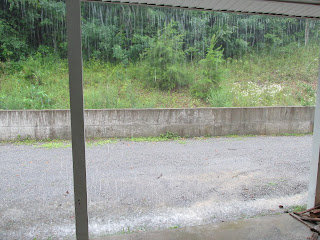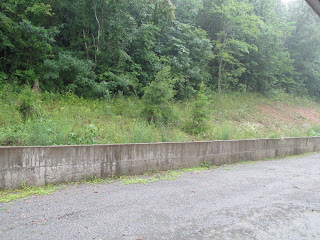Vines have rampaged along the fences.
High summer has never been a favorite time. I have lived in three quite distinct areas in terms of climate--in all three, July weather is too hot.
The greater part of my life was spent in Vermont's Champlain Valley, with the Green Mountains rimming the eastern horizon, the dark and rugged thrust of the Adirondacks looming on the New York side of the lake, visible as one drove to the far end of the township.
June--early summer there--brought pleasantly warm days; in my girlhood, June meant freedom from school, hours to roam in the burgeoning green meadows and woods of my Grampa Mac's farm. My sisters and I rode our bikes with the neighbor girls--also three sisters. If we got too warm, we ditched the bikes, flopped down in the grass, faces turned up to the endless blue of the sky.
Our mothers mixed endless pitchers of kool aid--sugary sweet, garishly colored in
faux-fruit flavors.
July segued in with long sultry days--nights too heavy with trapped heat and humidity for sleep.
Pedaling along the back roads or hiking up the pasture left one limp, head throbbing, out of sorts.
Yet, as children, so little was expected of us. We were free to spread a blanket in the shade of the silver maple and retreat there with a glass of lemonade and a library book.
Grampa Mac's farmhouse next door offered a relatively cool living room and his old rocking chair by the radio.
Adulthood, and a family of my own, brought a reality check: summer was no longer a time to play or lounge about trying to beat the heat.
July meant garden rows to weed, produce to be harvested, crawling along the ranks of green beans while sweat streamed down my back. July ushered in hours of canning--steam belching from kettles and heat leaching from the crowded kitchen, seeping into rooms with curtains drawn against the scorching sun.
Weeds have flourished in the area where I attempted to make a rough flower garden.
Before 'retiring' to Kentucky in 2010, we spent 12 years in Wyoming.
July in Wyoming is hot and dusty, with heat that is unrelieved by shade trees.
Afternoon temperatures soar into three digits--Fahrenheit.
The sun blazes down, brassy, relentless.
Each afternoon rough wind skirls down from the mountains, picking up grit and sand as it scours across the high arid plains. Grasshoppers bounce in the coarse browned grass.
Summer twilight lingers in Wyoming; sunsets are tinged with the smoke of forest fires.
The saving grace of July in Wyoming is the usual drop in night time temperatures.
As darkness deepens, cooler air flows down from the mountains. By the wee hours we reached to pull up the quilt folded at the foot of the bed.
Jim rose at daybreak to work before the sun rose to searing heights.
I wore a sweatshirt while sitting on the porch to sip my morning mug of hot tea or coffee.
Relief from July heat was to be found camping on weekends in the mountains where a heavy sleeping bag was needed to withstand temperatures that could plummet to nearly freezing by midnight.
Willis sulks in a tray of lavender seedlings on the porch.
July in south-central Kentucky is all about heat and intense humidity.
We have learned to garden early in the morning, then to retreat inside, close the windows, draw the curtains, turn on fans or A/C.
To step outside is to feel that one has been swathed and smothered in a hot steaming blanket.
July this year has been about rain--drenching rain, pounding rain, so much rain that the ground does not dry out before another deluge moves in.
The garden has succumbed to weeds and blight.
I need my wellies to walk down the path into the woods to the spot where I dump used cat litter.
A towel used once remains damp on the towel bar; I round up towels and clothing each day for laundry, unwilling to leave anything to develop a sour musty odor. I have used the electric dryer more often in July than in January!
Last week I discovered a slight film of mold creeping along the crevices of furniture.
Jim works doggedly at the renovation of the lower farmhouse, returning every few hours with his shirt plastered to his chest and back.
I paint a wall or two, then sag with exhaustion, hot and cranky.
We revive ourselves with iced tea, lemonade clinking with ice, fruit smoothies.
July, 2015, is nearly over. August looms.
It is still hot in August
August is also a month of transition, weather changes that are at first subtle, then more noticeable as the earth turns toward autumn.
There are cool mornings, afternoons when we can open the windows to a refreshing breeze.
I can deal with August, the month of waning summer.
July--I could do without July!











































